Yuxin Zuo
TTRL: Test-Time Reinforcement Learning
Apr 22, 2025Abstract:This paper investigates Reinforcement Learning (RL) on data without explicit labels for reasoning tasks in Large Language Models (LLMs). The core challenge of the problem is reward estimation during inference while not having access to ground-truth information. While this setting appears elusive, we find that common practices in Test-Time Scaling (TTS), such as majority voting, yield surprisingly effective rewards suitable for driving RL training. In this work, we introduce Test-Time Reinforcement Learning (TTRL), a novel method for training LLMs using RL on unlabeled data. TTRL enables self-evolution of LLMs by utilizing the priors in the pre-trained models. Our experiments demonstrate that TTRL consistently improves performance across a variety of tasks and models. Notably, TTRL boosts the pass@1 performance of Qwen-2.5-Math-7B by approximately 159% on the AIME 2024 with only unlabeled test data. Furthermore, although TTRL is only supervised by the Maj@N metric, TTRL has demonstrated performance to consistently surpass the upper limit of the initial model, and approach the performance of models trained directly on test data with ground-truth labels. Our experimental findings validate the general effectiveness of TTRL across various tasks, and highlight TTRL's potential for broader tasks and domains. GitHub: https://github.com/PRIME-RL/TTRL
Towards Event Extraction with Massive Types: LLM-based Collaborative Annotation and Partitioning Extraction
Mar 04, 2025Abstract:Developing a general-purpose extraction system that can extract events with massive types is a long-standing target in Event Extraction (EE). In doing so, the challenge comes from two aspects: 1) The absence of an efficient and effective annotation method. 2) The absence of a powerful extraction method can handle massive types. For the first challenge, we propose a collaborative annotation method based on Large Language Models (LLMs). Through collaboration among multiple LLMs, it first refines annotations of trigger words from distant supervision and then carries out argument annotation. Next, a voting phase consolidates the annotation preferences across different LLMs. Finally, we create the EEMT dataset, the largest EE dataset to date, featuring over 200,000 samples, 3,465 event types, and 6,297 role types. For the second challenge, we propose an LLM-based Partitioning EE method called LLM-PEE. To overcome the limited context length of LLMs, LLM-PEE first recalls candidate event types and then splits them into multiple partitions for LLMs to extract events. The results in the supervised setting show that LLM-PEE outperforms the state-of-the-art methods by 5.4 in event detection and 6.1 in argument extraction. In the zero-shot setting, LLM-PEE achieves up to 12.9 improvement compared to mainstream LLMs, demonstrating its strong generalization capabilities.
Code-Vision: Evaluating Multimodal LLMs Logic Understanding and Code Generation Capabilities
Feb 17, 2025Abstract:This paper introduces Code-Vision, a benchmark designed to evaluate the logical understanding and code generation capabilities of Multimodal Large Language Models (MLLMs). It challenges MLLMs to generate a correct program that fulfills specific functionality requirements based on a given flowchart, which visually represents the desired algorithm or process. Code-Vision comprises three subsets: HumanEval-V, Algorithm, and MATH, which evaluate MLLMs' coding abilities across basic programming, algorithmic, and mathematical problem-solving domains. Our experiments evaluate 12 MLLMs on Code-Vision. Experimental results demonstrate that there is a large performance difference between proprietary and open-source models. On Hard problems, GPT-4o can achieve 79.3% pass@1, but the best open-source model only achieves 15%. Further experiments reveal that Code-Vision can pose unique challenges compared to other multimodal reasoning benchmarks MMCode and MathVista. We also explore the reason for the poor performance of the open-source models. All data and codes are available at https://github.com/wanghanbinpanda/CodeVision.
MedXpertQA: Benchmarking Expert-Level Medical Reasoning and Understanding
Jan 30, 2025Abstract:We introduce MedXpertQA, a highly challenging and comprehensive benchmark to evaluate expert-level medical knowledge and advanced reasoning. MedXpertQA includes 4,460 questions spanning 17 specialties and 11 body systems. It includes two subsets, Text for text evaluation and MM for multimodal evaluation. Notably, MM introduces expert-level exam questions with diverse images and rich clinical information, including patient records and examination results, setting it apart from traditional medical multimodal benchmarks with simple QA pairs generated from image captions. MedXpertQA applies rigorous filtering and augmentation to address the insufficient difficulty of existing benchmarks like MedQA, and incorporates specialty board questions to improve clinical relevance and comprehensiveness. We perform data synthesis to mitigate data leakage risk and conduct multiple rounds of expert reviews to ensure accuracy and reliability. We evaluate 16 leading models on MedXpertQA. Moreover, medicine is deeply connected to real-world decision-making, providing a rich and representative setting for assessing reasoning abilities beyond mathematics and code. To this end, we develop a reasoning-oriented subset to facilitate the assessment of o1-like models.
AlignXIE: Improving Multilingual Information Extraction by Cross-Lingual Alignment
Nov 07, 2024
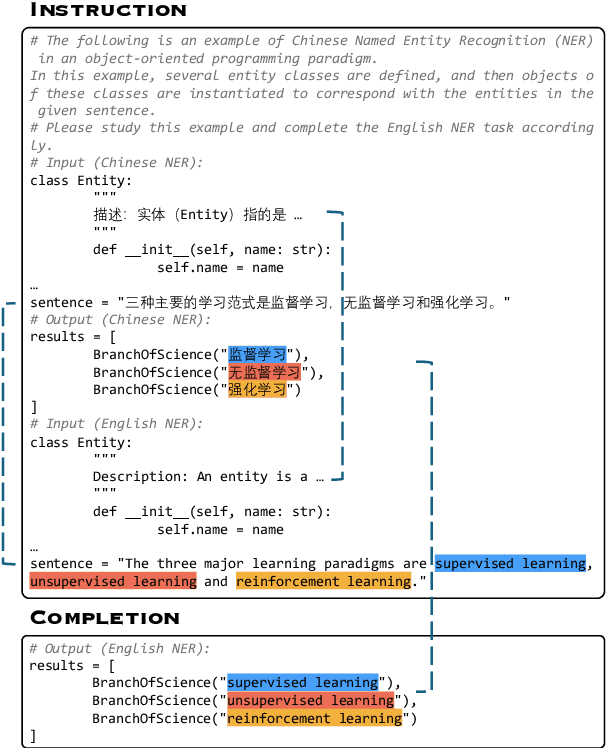

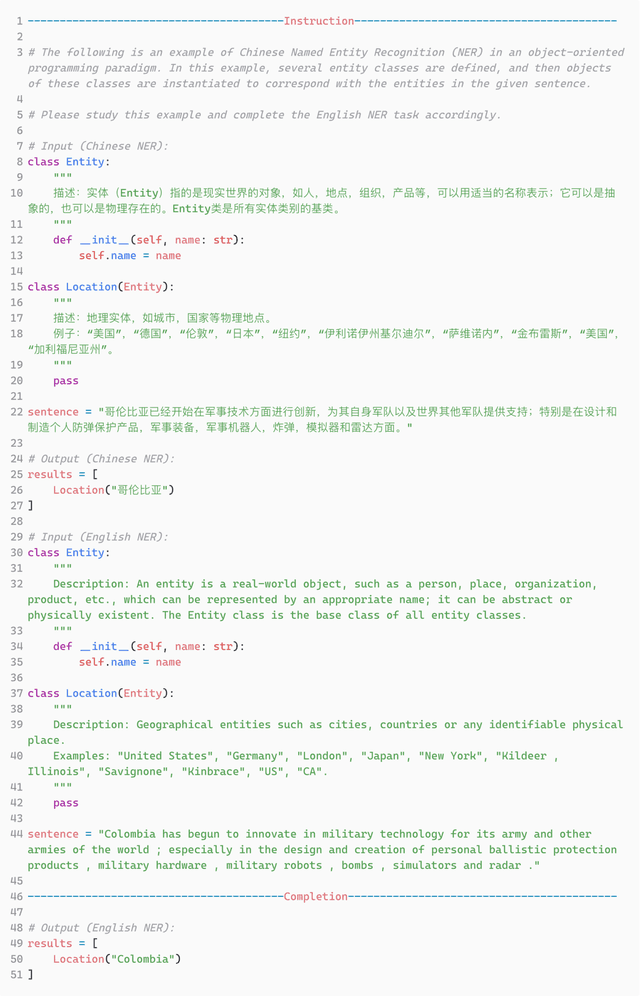
Abstract:Empirical evidence suggests that LLMs exhibit spontaneous cross-lingual alignment. Our findings suggest that although LLMs also demonstrate promising cross-lingual alignment in Information Extraction, there remains significant imbalance across languages, revealing an underlying deficiency in the IE alignment. To address this issue, we propose AlignXIE, a powerful code-based LLM that significantly enhances cross-lingual IE alignment through two strategies. Firstly, AlignXIE formulates IE across different languages, especially non-English ones, as code generation tasks, standardizing the representation of various schemas using Python classes to ensure consistency of the same ontology in different languages and align the schema. Secondly, it incorporates an IE cross-lingual alignment phase through a translated instance prediction task proposed in this paper to align the extraction process, utilizing ParallelNER, an IE bilingual parallel dataset with 257,190 samples, generated by our proposed LLM-based automatic pipeline for IE parallel data construction, with manual annotation to ensure quality. Ultimately, we obtain AlignXIE through multilingual IE instruction tuning. Although without training in 9 unseen languages, AlignXIE surpasses ChatGPT by $30.17\%$ and SoTA by $20.03\%$, thereby demonstrating superior cross-lingual IE capabilities. Comprehensive evaluations on 63 IE benchmarks in Chinese and English under various settings, demonstrate that AlignXIE significantly enhances cross-lingual and multilingual IE through boosting the IE alignment.
Automating Exploratory Proteomics Research via Language Models
Nov 06, 2024Abstract:With the development of artificial intelligence, its contribution to science is evolving from simulating a complex problem to automating entire research processes and producing novel discoveries. Achieving this advancement requires both specialized general models grounded in real-world scientific data and iterative, exploratory frameworks that mirror human scientific methodologies. In this paper, we present PROTEUS, a fully automated system for scientific discovery from raw proteomics data. PROTEUS uses large language models (LLMs) to perform hierarchical planning, execute specialized bioinformatics tools, and iteratively refine analysis workflows to generate high-quality scientific hypotheses. The system takes proteomics datasets as input and produces a comprehensive set of research objectives, analysis results, and novel biological hypotheses without human intervention. We evaluated PROTEUS on 12 proteomics datasets collected from various biological samples (e.g. immune cells, tumors) and different sample types (single-cell and bulk), generating 191 scientific hypotheses. These were assessed using both automatic LLM-based scoring on 5 metrics and detailed reviews from human experts. Results demonstrate that PROTEUS consistently produces reliable, logically coherent results that align well with existing literature while also proposing novel, evaluable hypotheses. The system's flexible architecture facilitates seamless integration of diverse analysis tools and adaptation to different proteomics data types. By automating complex proteomics analysis workflows and hypothesis generation, PROTEUS has the potential to considerably accelerate the pace of scientific discovery in proteomics research, enabling researchers to efficiently explore large-scale datasets and uncover biological insights.
KnowCoder: Coding Structured Knowledge into LLMs for Universal Information Extraction
Mar 14, 2024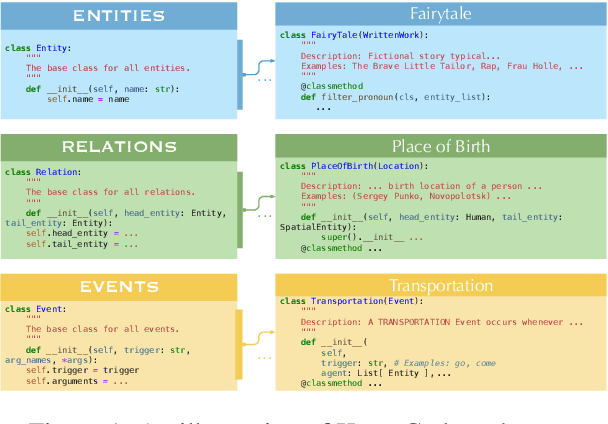

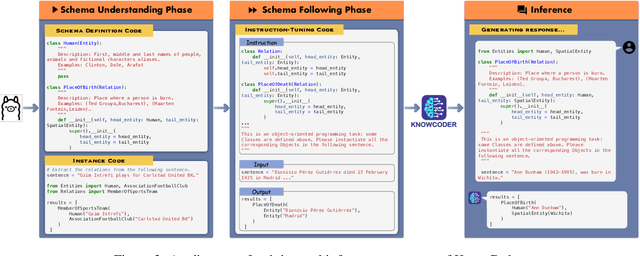
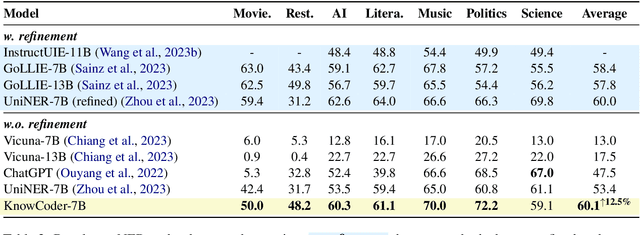
Abstract:In this paper, we propose KnowCoder, a Large Language Model (LLM) to conduct Universal Information Extraction (UIE) via code generation. KnowCoder aims to develop a kind of unified schema representation that LLMs can easily understand and an effective learning framework that encourages LLMs to follow schemas and extract structured knowledge accurately. To achieve these, KnowCoder introduces a code-style schema representation method to uniformly transform different schemas into Python classes, with which complex schema information, such as constraints among tasks in UIE, can be captured in an LLM-friendly manner. We further construct a code-style schema library covering over $\textbf{30,000}$ types of knowledge, which is the largest one for UIE, to the best of our knowledge. To ease the learning process of LLMs, KnowCoder contains a two-phase learning framework that enhances its schema understanding ability via code pretraining and its schema following ability via instruction tuning. After code pretraining on around $1.5$B automatically constructed data, KnowCoder already attains remarkable generalization ability and achieves relative improvements by $\textbf{49.8%}$ F1, compared to LLaMA2, under the few-shot setting. After instruction tuning, KnowCoder further exhibits strong generalization ability on unseen schemas and achieves up to $\textbf{12.5%}$ and $\textbf{21.9%}$, compared to sota baselines, under the zero-shot setting and the low resource setting, respectively. Additionally, based on our unified schema representations, various human-annotated datasets can simultaneously be utilized to refine KnowCoder, which achieves significant improvements up to $\textbf{7.5%}$ under the supervised setting.
DSCom: A Data-Driven Self-Adaptive Community-Based Framework for Influence Maximization in Social Networks
Nov 18, 2023Abstract:Influence maximization aims to find a subset of seeds that maximize the influence spread under a given budget. In this paper, we mainly address the data-driven version of this problem, where the diffusion model is not given but needs to be inferred from the history cascades. Several previous works have addressed this topic in a statistical way and provided efficient algorithms with theoretical guarantee. However, in their settings, though the diffusion parameters are inferred, they still need users to preset the diffusion model, which can be an intractable problem in real-world practices. In this paper, we reformulate the problem on the attributed network and leverage the node attributes to estimate the closeness between the connected nodes. Specifically, we propose a machine learning-based framework, named DSCom, to address this problem in a heuristic way. Under this framework, we first infer the users' relationship from the diffusion dataset through attention mechanism and then leverage spectral clustering to overcome the influence overlap problem in the lack of exact diffusion formula. Compared to the previous theoretical works, we carefully designed empirical experiments with parameterized diffusion models based on real-world social networks, which prove the efficiency and effectiveness of our algorithm.
Incorporating Probing Signals into Multimodal Machine Translation via Visual Question-Answering Pairs
Oct 26, 2023Abstract:This paper presents an in-depth study of multimodal machine translation (MMT), examining the prevailing understanding that MMT systems exhibit decreased sensitivity to visual information when text inputs are complete. Instead, we attribute this phenomenon to insufficient cross-modal interaction, rather than image information redundancy. A novel approach is proposed to generate parallel Visual Question-Answering (VQA) style pairs from the source text, fostering more robust cross-modal interaction. Using Large Language Models (LLMs), we explicitly model the probing signal in MMT to convert it into VQA-style data to create the Multi30K-VQA dataset. An MMT-VQA multitask learning framework is introduced to incorporate explicit probing signals from the dataset into the MMT training process. Experimental results on two widely-used benchmarks demonstrate the effectiveness of this novel approach. Our code and data would be available at: \url{https://github.com/libeineu/MMT-VQA}.
 Add to Chrome
Add to Chrome Add to Firefox
Add to Firefox Add to Edge
Add to Edge